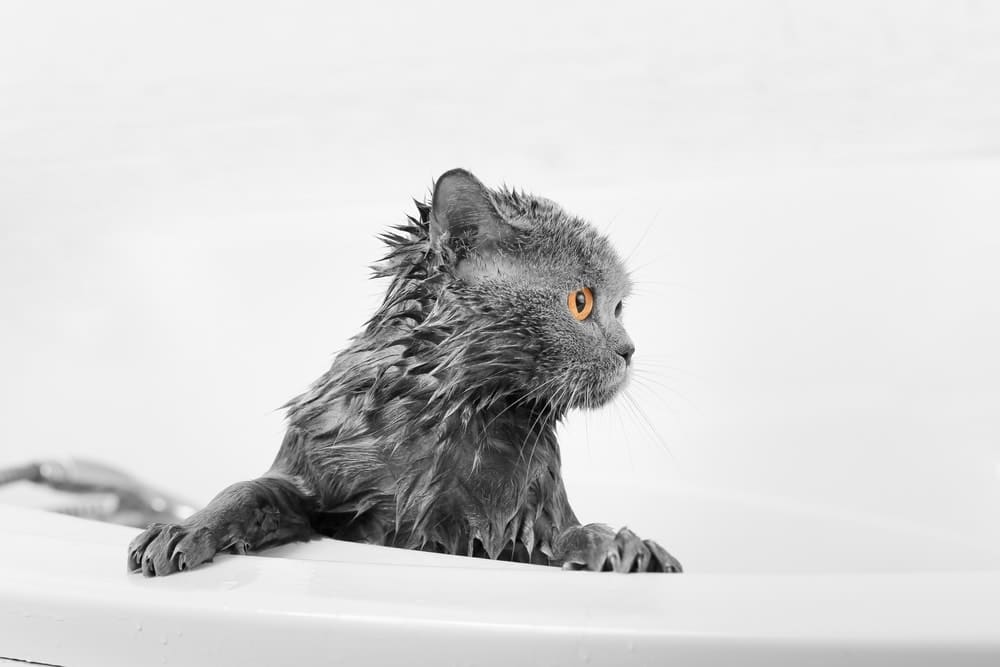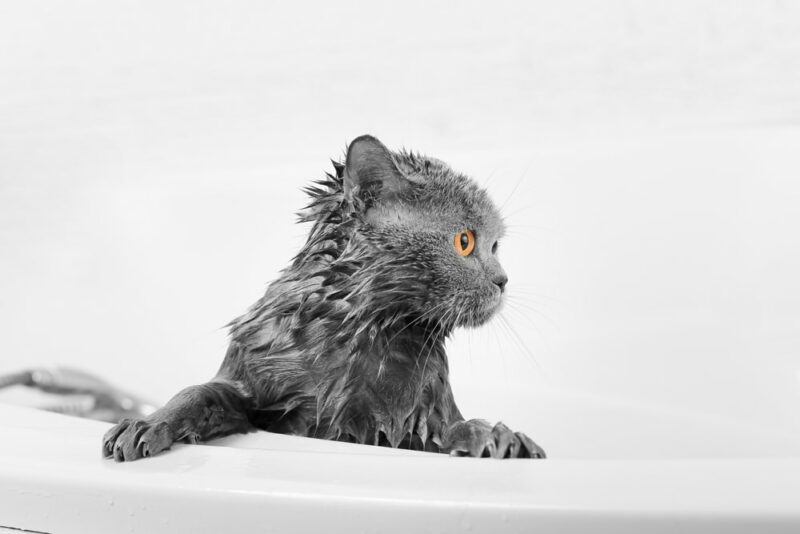All feline owners are familiar with dreaded bath days. It’s hard to say who enjoys it less—you or your cat. Most felines do not tolerate water well and can do some serious damage if they feel insecure. Those claws are no joke!
It might be such a hassle that you wonder if it’s really worth all the fuss. So, is cat-bathing overhyped or does it serve a real benefit? The truth is, despite all of the self-cleaning cats do, there are circumstances in which a bath is absolutely necessary. For example, they will need a bath if they soiled themselves when ill; got covered with mud, paint, or other chemicals; were prescribed it as a treatment for flies, yeast, or bacterial infections; or got sprayed by a skunk. Baths might also be necessary for cats that cannot properly groom themselves due to being overweight or having arthritis, among other health issues. Let’s discuss the importance of kitty hygiene.
Do Cats Like Baths?
Some cats really like water, others are curious about it—and then there are those classic felines that absolutely despise being anywhere near water. It’s as if your cat is the Wicked Witch of the West, melting into a puddle each time they get close to it.
Even when you expose cats to water at an early age, they might hate it all their life. That makes it really hard when it comes to bath time. Acclimating a young kitty has much higher success rates with bath tolerance, but each cat will respond based on their individual personality.
Unless you have a special case, you can almost guarantee your cat won’t be crazy about bath time. They are wet, cold, and helpless—and we all know how our cats hate feeling dependent.
How Often to Bathe Your Cat
All cats have different coats, habits, and behaviors, so there are no set rules about their bathing frequency. If you have a constantly self-grooming cat with short fur, you might be able to wait a little longer in some scenarios. However, if you have a hairless cat, you will need to bathe them every couple of weeks to help them remove the oily buildup on their skin. Once you find what works best for your cat, you can create a grooming schedule.
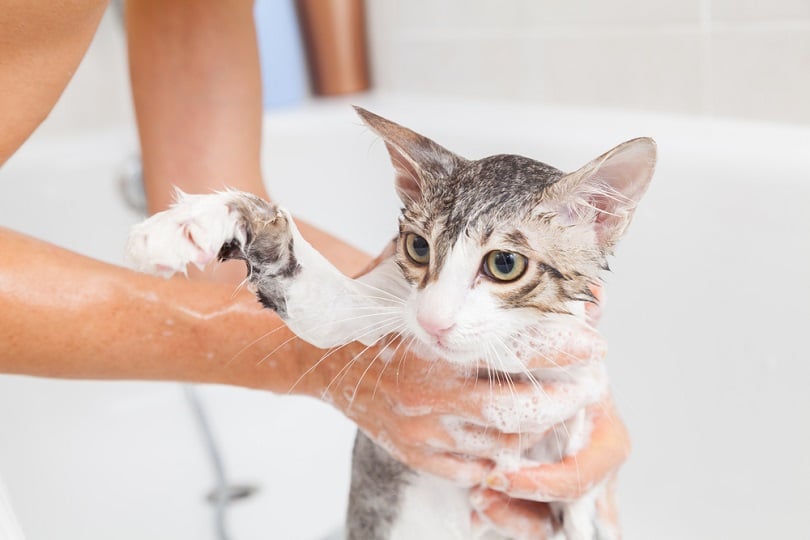
Benefits of Cat Bathing
- Bathing removes any dirt or debris in the fur.
- Bathing leaves your cat’s coat soft and refreshed.
- It reduces the likelihood of matting or tangling.
- It keeps your furniture and fabrics clean.
- It removes any litter box leftovers from their paws.
Why You Shouldn’t Over-Bathe Your Cat
Cats are very good at grooming themselves naturally. Plus, their skin excretes oils to protect their fur and keep it nice and shiny. If you strip the oils too often, it can make the coat dim or lackluster.
The overuse of shampoo might even cause skin irritation, dry and flaky skin, and hair loss. Use only cat-safe, proven shampoo brands that match your feline’s pH levels.
Other Times to Bathe Your Cat
Of course, cats might have a different plan when it comes to getting dirty. Sometimes, you will have to bathe your cat sooner than the schedule says.
- If your cat is filthy with dirt
- If they have something sticky in their fur
- If they have something potentially harmful on their coat
- If they have excessive tangles
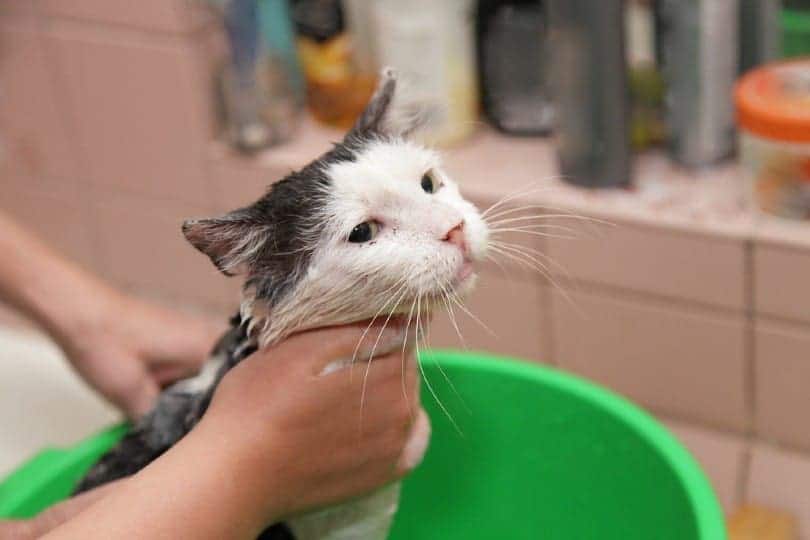
If any of these situations occur, it’s okay to bathe your cat. But try to stretch out bath time when you can.
Cat-Friendly Shampoo Options
When you buy shampoo, it should always be specifically formulated for felines. These shampoos have the right ingredients and pH levels to appropriately clean your cat.
However, not all shampoos are created equal in the pet supply world. Cat shampoo should have soothing, all-natural properties.
- Harsh or toxic chemicals
- Parabens and sulfates
- Alcohol and other drying agents
- Essential oils like lavender or eucalyptus
*Tip: Never use human or dog shampoo on your cats.
The best pet shampoos are carefully formulated to clean your pet without causing irritation. Hepper's Colloidal Oatmeal Pet Shampoo does a great job of this by combining soothing ingredients like aloe vera and colloidal oatmeal. It is also pH-balanced and free of irritants like dyes, soaps, sulfates, and phthalates. You and your pet will both enjoy the fresh, clean scent, too!
At Catster, we’ve admired Hepper for many years and decided to take a controlling ownership interest so that we could benefit from the outstanding designs of this cool cat company!
How to Bathe Your Cat
Bathing styles can vary depending on your cat’s temperament. When it’s time for a bath, you can give your cat the royal treatment. Use this as an opportunity to take care of other basic hygiene, like nail clipping, teeth brushing, and fur detangling.
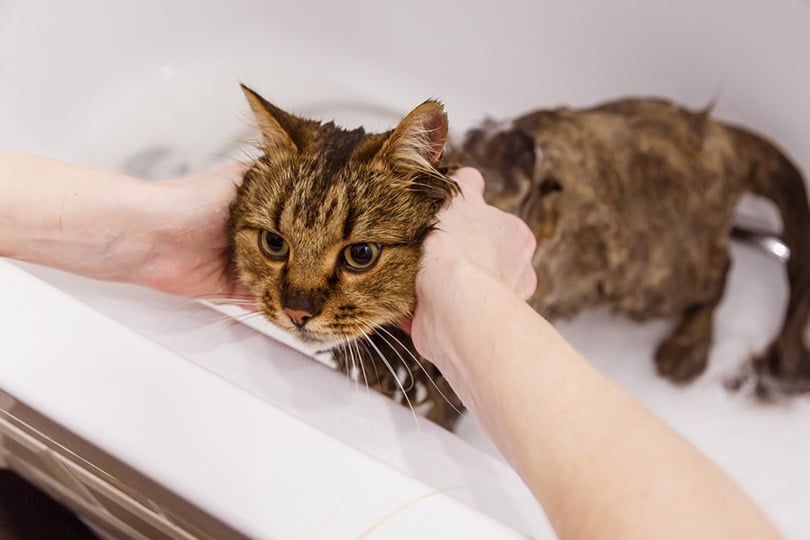
- Towel
- Cat-friendly shampoo
- A rinsing cup
- Gloves
- A brush
Here’s a Painless Way to Bathe Your Cat:
- Ready your cat for bath time. Round them up, and make sure you have anything you need for bath time bribery—like yummy treats.
- Draw a few inches of lukewarm water in a sink or tub. Make sure the water isn’t too hot or cold for your kitty. You want them to be as comfortable as possible.
- Make sure you have all the necessary supplies. Don’t start the bath and forget the towel. Double-check to see if all your supplies are on standby.
- Put on your gloves and any other protective gear. Gloves can help protect your skin from your cat’s claws if they stress out or struggle.
- Making your cat feel as secure as possible, lower them into the water. If you need a partner for this part, more power to you. Whatever it takes to make your cat feel at ease.
- Lather their bodies with shampoo and gently scrub. You can use about a quarter-sized portion of shampoo to get a nice lather, but you might need more, depending on fur length.
- Rinse thoroughly. You won’t want to leave any shampoo to dry in their fur, as this can irritate their skin.
- Using only water on a rag, clean your cat’s face last. You don’t want to get any soap on the face because of sensitive parts like eyes and ears. With a damp cloth, gently clean the face.
- Wrap up your kitty in a towel. Make sure to snuggle them a little extra since you just traumatized them in the tub. Gently rub or dab your kitty until they’re mostly dry before you let them go. You won’t want them shivering. If where you live is cold, you might have to use a hairdryer on the lowest setting to completely dry them. If you choose this method, be sure to constantly move the dryer and avoid only focusing on one spot.
- Do any cleanup or aftercare. Now it’s time to do any extras, like brushing, ear cleaning, tooth brushing, and nail clipping. Then, you get to clean up the mess with no help from the cat.
How to Ease Your Cat’s Stress During Bath Time
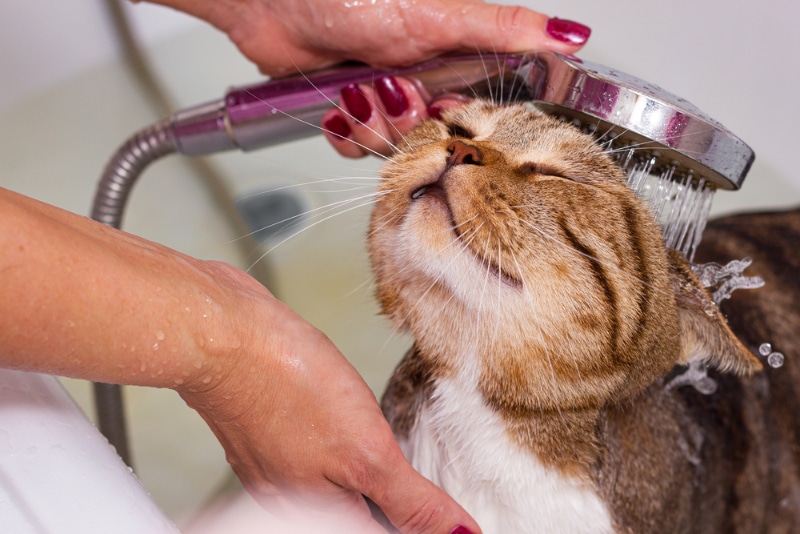
Baths can be traumatic for cats, especially if you don’t do it correctly. Water typically makes them feel very insecure, so making sure that they feel safe is paramount. You don’t want to have a lousy bath experience because it will most certainly lead to others.
- Learn your cat’s body language.
- Talk to them in a soothing voice.
- Have a partner help you out if needed.
- Learn whether your cat likes to have a bath drawn vs. running water.
- Offer yummy treats.
- Give them lots of snuggles afterward.
Final Thoughts
So, even though your cat might despise bath time, it’s a necessary part of cat care. Some cats might need baths less often than others. It depends on the situation and environment and the characteristics and habits of your cat. But for one reason or another, nearly every pet cat will need a bath sometime! It isn’t a myth—but a professional recommendation.
Your cats might not like it so much, but they will feel better once all is said and done.
See Also:
- Why Does My Cat Watch Me Shower? Behaviour Unveiled
- Do Long-Haired Cats Need Baths? Vet Approved Grooming Advice
Featured Image Credit: Zulkarnieiev Denis, Shutterstock

